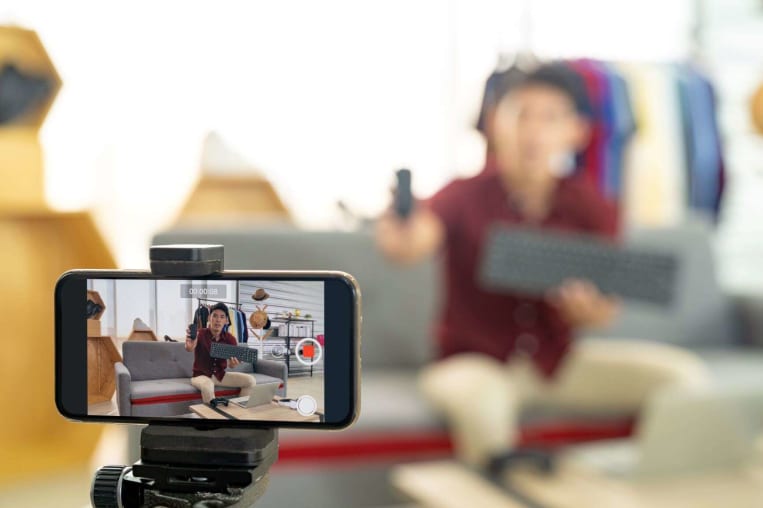
BBB Tip: Social media Influencers: How they're changing the marketplace and tips to avoid fraud

(Getty)
Originally published May 2021
Today's digital world provides windows into others' lives and far-away places that were once cut off to the average person. Want to see the world? You can follow world travelers who have captured images of beaches, sunsets, tavernas, and hotels. Interested in fashion tips? Jump online to find people sharing tips for style and beautification. Interested in learning a new skill, such as home remodeling, scrapbooking, or auto repair? Go online to find the right teacher. And that is not it. You can follow athletes of all stripes engaging in jaw-dropping action or experience the moments of joy that come with children unboxing a brand-new toy with their parents or meeting a new sibling or pet. And if you are bored, you can pick up your smartphone to watch a brand-new video from your favorite entertainer.
In this article, we will explore the marketplace phenomenon of social media influencers and content creators. We will highlight some well-known influencers on multiple platforms and alert you to potentially fraudulent practices you should watch out for.
Who are social media influencers and content creators? Where can I find them?
Younger consumers increasingly spend their free time on social media platforms such as Snapchat, TikTok, Instagram, YouTube, Facebook, and Twitter. Influencers and content creators are social media users who have leveraged their personalities, travels, stories, and/or talents to acquire many online followers, many of whom are young. [1] And as influencers extend their reach across the digital world, brands are eager to gain access to the new consumers who follow them.
What are the opportunities?
Big brands and advertisers covet influencers' impact on their followers, and they engage with influencers hoping to tap into their reach and appearance of authenticity. By partnering with an influencer, a brand can promote its product and service in a way that doesn’t resemble traditional advertising. Notably, Google searches for “influencer marketing” grew 1,500% between 2015 – 2018. [2]
Many content creators and influencers partner with brands to promote products and services in their video streams and social media feeds. Others use their influence to promote their businesses to their followers and subscribers. Major social media companies have also built new features into their platforms that content creators and influencers use to make money from their feeds. Recently, small and up-and-coming businesses have also contacted influencers to gain new, young customers.
Authenticity offers value
Their authenticity makes a particular influencer or content creator valuable to a brand or advertiser. Influencers and content creators build followers of people who share their interests or passions. This contrasts with traditional advertising, native advertising, or even interest-based advertising. With an influencer, a consumer feels they are interacting with a real person in their life, like a close friend or family member. Advertisers aim to harness this unique relationship between an influencer and his/her followers. Indeed, tapping into this authenticity has become a major marketing strategy for reaching Generation Z, roughly described as individuals born after 1996 to 2015 who are known for growing up in the digital world. [3] Brands are hungry to reach this generation, especially through tapping into Instagram influencers and YouTube content creators.
The big players
Some famous social media influencers have obtained millions of followers. On YouTube, Swedish content creator Felix Arvid Ulf Kjellberg, who goes by PewDiePie, is known for video game tips, comedy, and commentary on meme culture. His popular content on YouTube allowed him to amass over 110 million followers. Dude Perfect, a sports entertainment group, follows behind with 56 million followers. Top influencers and content creators on YouTube include Brazilian video blogger Felipe Neto and “kidfluencer” Nastya.
Top Instagram accounts feature celebrities, athletes, and artists such as Karim Benzema, Jennifer Lopez, and Katy Perry, but also National Geographic and NASA, whose followers number in the millions. Popular influencers on Snapchat include American hip-hop producer DJ Khaled and fashion model Jelena Noura “Gigi” Hadid. On Twitter, popular accounts include individuals with backgrounds and expertise as diverse as Rihanna, Cristiano Ronaldo, Narendra Modi, Justin Bieber, and former President Barack Obama.
The medium and small players
Mid-tier influencers have followings that range from roughly 50,000 to 500,000.[4] These influencers include individuals with a vast range of interests. Besides world travelers, fashion experts, and food bloggers, mid-tier influencers also have personalities that focus on parenting, do-it-yourself, emerging technology, religion, and journalism. With audiences from various educational, cultural, and economic backgrounds, these influencers are often viewed as more trustworthy and relatable than larger players because their content appears more authentic. [5]
New international platforms for Influencers
Influencers are making their mark on Instagram, YouTube, Snapchat, and other platforms, but new players are emerging in our interconnected world. TikTok, based in China, is an app that encourages users to create short-form video content. In the first quarter of 2021, TikTok was the most downloaded mobile app worldwide, followed by Facebook and Instagram. [6] As China increases its global digital footprint, the potential for new content creators on emerging platforms continues to grow.
Watching out for fraud
Anytime new platforms arise and bring opportunities to generate revenue; fraud is likely to follow. The Fyre Festival – a failed event reported to have cost investors $26 million and is the subject of ongoing lawsuits -- has become emblematic of fraud in the influencer space. [7] This event, the subject of Netflix and Hulu documentaries, was known for planners using influencers to promote a luxury Bahamas music festival on Facebook and Instagram. This resulted in partygoers traveling overseas to the event, only to learn the festival was canceled; they paid thousands of dollars to stay in disaster-relief tents without access to plumbing, running water, or hot food.
Some influencers have also used bots to inflate followers artificially, and some companies have profited by selling fake followers to influencers. Other influencers have knowingly promoted fake or faulty products.
Below are a few tips to help consumers avoid fraud and help businesses be on the lookout for untrustworthy influencer partners:
• Be skeptical about exaggerated claims for a particular product, trip, or service.
• Be aware of high spikes in follower count for an influencer or content creator.
• Look in the comments section for a high number of generic or irrelevant comments – comments that only contain emojis or one or two words or don’t appear to comment on the content of the posting, for example.
• Keep an eye out for followers from distant places; if an influencer based in Virginia has many commentators from Asia or Africa, they may be artificial.
• Look for verification marks from platforms – some social media companies will verify influencers with a special marker if they appear to have many followers. For example, Instagram has a blue checkmark for accounts it has verified for a public figure, celebrity, or brand.
Rules of the road: Influencers must disclose their relationships
It’s critical for influencers and businesses that partner with them to understand the laws regarding truth in advertising, disclosure, and fairness. While the legal landscape is still emerging, legal rules and guidelines exist for using hashtags, curating comments, adding followers, and announcing relationships with brands. Influencers and their business partners need to look closely at these requirements to ensure they follow the law. Another article on social media influencers will do a deeper dive into some of the laws that impact influencers.
This article is one of two about social media influencers. Both articles can be found at BBB.org/Ad-Truth and were created with financial support provided by Google.
[1] 71% of Instagram users are under 35: https://influencermarketinghub.com/influencer-marketing-statistics/ Distribution of Instagram influencers creating sponsored posts: 31% are 18-24, 54% are 25-24: https://www.statista.com/statistics/893733/share-influencers-creating-sponsored-posts-by-age/
[2] https://influencermarketinghub.com/influencer-marketing-benchmark-report-2020/ [3] https://www.salesforce.com/blog/2017/10/how-millennials-and-gen-z-are-different.html
[4] https://www.wsj.com/articles/online-influencers-tell-you-what-to-buy-advertisers-wonder-whos-listening-11571594003, see also https://medium.com/socialbook/a-quick-guide-to-starting-your-first-influencer-marketing-campaign-598bebaf4d54
[5] https://www.digitalinformationworld.com/2019/11/influencers-are-more-trusted-than-celebrities-as-brand-spokespeople.html, see also https://adage.com/article/wp-engine/gen-z-doesnt-want-buy-your-brand-they-want-join-it/2163281, see also, https://www.ceotodaymagazine.com/2019/11/real-life-in-the-digital-world-gen-zs-search-for-authenticity/
[6] https://www.adweek.com/media/app-annie-tiktok-led-worldwide-app-downloads-in-q1-2021/
[7] https://www.cnbc.com/2019/08/18/how-fyre-festivals-organizer-scammed-investors-out-of-26-million.html, see also https://www.rollingstone.com/music/music-news/fyre-festival-14-lawsuits-talent-agencies-927897/, see also https://www.digitalmusicnews.com/2020/12/04/fyre-festival-lawsuit-update/
Still Need Assistance?
Contact Your Local BBB
Your local Better Business Bureau can assist you with finding businesses you can trust. Start With Trust®.
Additional Resources
Let BBB help you resolve problems with a business
Research and report on scams and fraud using BBB Scam Tracker
Learn more about the value of BBB Accreditation